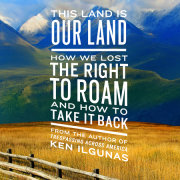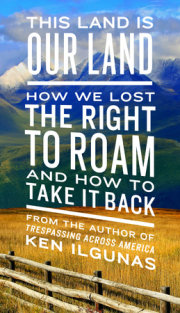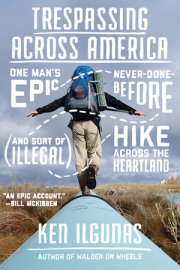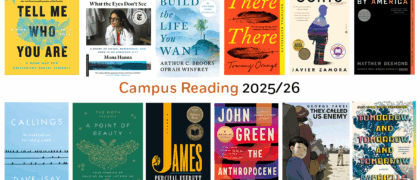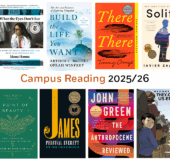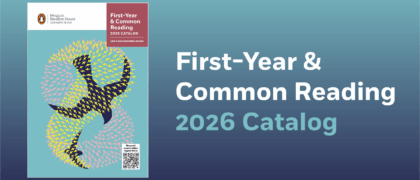Chapter 1
The Right to Roam
My first years were spent living just as my forefathers had lived-roaming the green, rolling hills.
-Chief Luther Standing Bear, Land of the Spotted Eagle, 1933
As a travel writer, I have the bad habit of writing about myself. I plant forests of I's over pages and leave behind trails of thoughts and feelings that I think will change the world but that only succeed in embarrassing me. A historical and political book of this nature warrants a more formal and less personal style. While this book, outside of this chapter, may come across as impersonal, I do wish to say up front that it has in fact been written with passion and feeling. For me, the seemingly boring subjects of property law, land-use planning, and public access legislation are, well, personal.
Let me start by telling you about where I grew up. On the western edge of New York State, between the cities of Buffalo and Niagara Falls, is Wheatfield. Sprawling over twenty-eight square miles of mostly flat land and bordered on one end by the mighty Niagara River, Wheatfield was not too long ago a countryside of forests and cornfields.
Before white settlers moved into the area in the mid-1800s, the land was a relatively untouched forest inhabited by Native American tribes. Wheatfield's soil is well suited for growing wheat, so when the settlers arrived, wheat became a local staple. Then came the Erie Canal. Then industry grew, both in Buffalo and Niagara Falls. And in the second half of the twentieth century, the middle class fled the cities to live out the suburban American Dream. In less than two hundred years, the character of the land shifted from wild to farm to suburb.
If you drive through Wheatfield today, you might not be all that impressed. The town's schools, churches, pizzerias, ballparks, retirement homes, and shopping centers are scattered incoherently. You'd see that it's just yet another poorly planned American town, aggressively developed without aesthetic vision or forethought. Its natural beauties-of which there are plenty-are obscured by the fast roads, endless subdivisions, and RV dealership monstrosities. It is, shall we say, a town without charm. Since there is no Main Street, town center, or civic landmark, it's a stretch to even call it a "town" with all the connotations of cohesion that being a town implies.
Yet it is a place that remains happy and peaceful in my dreams, for it was-for a time at least-a boyhood paradise. My family was among the first to move into a subdivision in Wheatfield called Country Meadows. During our first couple of years in Country Meadows, my brother and I would play in a thin stand of woods between our backyard and a cornfield. In the adjoining lot, still wild and vacant, we skated on a pond in the winter and collected tadpoles from it in the summer.
A bunch of new families had just moved to Wheatfield, which back in the late 1980s was mostly farms and fields. We were all strangers. We were all trespassers. There weren't any grouchy old landowners. There weren't any exclusionary signs, rules, or customs. It was a suburb without fences. It was a countryside without guns. And it was suddenly populated by a bunch of excited working-class families who'd just bought their first homes.
My boyhood friends and I roamed over the muddied construction lots, passed through woods, and extended our little football fields and baseball diamonds onto our neighbors' newly planted lawns. We played in the neighborhood's half-constructed homes, some of us laying siege to our friends inside those plywood castles with an artillery of mud clumps. We stole scrap lumber and built forts in the woods behind my home. My family let our golden retriever out, night or day, to sniff and chase and wander where he wished, unleashed. Later, as teenagers, we walked between homes to play football on a huge stretch of grass behind our subdivision. We never thought to ask who owned that grass.
I remember the storms of cawing blackbirds that would descend to feed on our back lawn. I remember the stink of the freshly manured cornfield. I remember the humid summer nights, the smell of raw pumpkin pulp, the lawns bronzed with blankets of fall foliage. I remember the snow tunnels and snowball wars. In all of my years in Country Meadows, I can remember only one sharp word from a homeowner for trespassing. For the most part, I remember a land without fences. Without signs. Without prohibitions.
But don't let me paint too idyllic a picture. My adolescence wasn't all skinned knees and wilderness adventures. And I was no Huck Finn. I spent plenty of time inside, too, playing more than my share of video games and watching more than my share of TV. These were the 1990s, after all. There were Saturday morning cartoons, Sega games, air-conditioning, and many other things that tempted us to remain indoors. But it was also a time before the Internet, before the ubiquity of home computers, before helicopter parents, and before kids owned their own phones. My friends and I, more often than not, left the comforts of home to roam the neighborhood unsupervised to play until dark.
Our rural-suburban dream wouldn't last forever, though. As my brother and I grew up, Wheatfield's rural landscape was swiftly changing character. Nearby fields became smothered in asphalt. Forests were hacked down to make way for yet more subdivisions. Between 1990 and 2010, over three thousand housing units were added, and the town's population increased 39 percent, from eleven thousand to eighteen thousand people. It was one of the fastest-growing towns in all of New York State.
My neighborhood expanded like the rest of Wheatfield, and this is just a small sample of what has been happening in America since World War II. According to the United States Department of Agriculture, between 1982 and 2007 forty-one million acres of American forest and farmland were bulldozed, largely because of urban growth, reducing our country's forest and farmland by about the size of Wisconsin.
These days in Country Meadows there are no green spaces for kids to explore anymore. There's no more collecting tadpoles. There are no more woods for building forts, no more ponds for ice-skating. Walk the roads and you'll see new "No Trespassing" signs around the remaining woods. The dogs are all safely locked behind electric fences. There are no sidewalks or public trails. The subdivision itself is quiet, gets little traffic, and is good for a stroll. But walkers and cyclists are essentially locked inside a couple of adjacent subdivisions by a surrounding network of noisy and dangerous roads. If you happen to see someone walking or cycling outside of the development on one of these busy streets, you assume that they're either destitute or crazy.
I begin this book in Wheatfield not because the place is unusual. I begin it in Wheatfield because Wheatfield is so ordinary. Many Americans, whether in cities, suburbs, or even rural areas, lack green places and safe places to walk. Most of our cities and towns have been developed with drivers in mind, not pedestrians. Every year, vehicles kill thousands of Americans out walking. The organization Smart Growth America reported that from 2003 to 2012 more than 47,000 pedestrians were killed (sixteen times the number of Americans killed by tornadoes, hurricanes, floods, and earthquakes combined), and an estimated 676,000 were injured walking along roads.
Our lack of safe and peaceful walking places may contribute to our status as one of the more sedentary countries in the world. In 2010, the journal Medicine & Science in Sports & Exercise reported that Americans walked an average of 5,117 steps a day, almost half of what the health community recommends and far fewer than the averages of the other countries the researchers studied, including Australia (9,695), Switzerland (9,650), and Japan (7,168). According to a 2012 study by The Lancet, 41 percent of Americans qualify as sedentary for not getting the recommended 150 minutes of exercise per week. In 2015, the National Center for Health Statistics reported that, among Americans over twenty years old, 71 percent are overweight and 38 percent are obese.
Today, from my family's front door, there is essentially no practical or scenic place to walk to-no store, no community center, no church, no forest grove, no flowery meadow-so the only walkers are the recreation walkers, and we are far too few. Many of my friends, family, and neighbors have suffered as a result. People I love and care about have weight problems and diseases like type 2 diabetes. The people of my neighborhood are generally civically disengaged and socially isolated. In Country Meadows, I remember one block party from my youth, when one especially sociable family hosted a giant get-together on their lawn, with drinks for the adults and games for the kids. But that was an exception to the rule. Most neighbors don't talk or even wave hello when passing each other by. My family has lived in this neighborhood since 1989, yet we don't know the names of our neighbors just two houses down.
Don't get me wrong: Country Meadows is a good neighborhood. In Country Meadows, there is no crime or gang violence. You don't have to lock your doors when you leave the house. Kids don't even smash pumpkins anymore. But just because it's free of hardship and suffering doesn't mean that we can't call for something better-a Country Meadows, perhaps, where everyone has more access to nature, a greater sense of freedom, and better health.
Since graduating from college, I've called a number of other places home. I moved to the rolling, red-clay hills of the North Carolina Piedmont, where on the roads around me I estimate that three out of every five property owners have posted "No Trespassing" signs. Barred from these woodlands, walkers are forced to stay on winding, shoulderless roads. We walkers have to keep an eye out for reckless drivers, and we can anticipate a belligerent honk or two. In York County, Nebraska, I lived in between corn and soybean fields, where virtually every foot of green space was devoted to industrial agriculture.
One solution to our walking problems is to design better communities with safe walking in mind. Our country's leading walking organization, America Walks, is working toward this goal. And books like Jeff Speck's Walkable City and Suburban Nation discuss how we can design our cities and suburbs better. A pleasant walk to the post office, though, only gets you so far.
A more radical solution-which is the subject of this book-is "the right to roam." The right to roam is an American tradition dating back to our nation's origins, when ordinary folks had the right to walk through privately owned woods and fields, and along the coasts. While this may seem like a vestige of our past, gone forever like the flocks of passenger pigeons whose migrations once darkened our skies, there is reason for hope. In several European countries this freedom has been reborn and is thriving, suggesting that it can be reborn here.
I've fallen in love with the right to roam. Maybe it started as a boy, when I got to roam my half-built suburb as I wished. Or maybe it was later in life when I took offense at all the "No Trespassing" signs. Or maybe it was in northern Alaska, where I lived and worked and could walk wherever I wanted. With a map in one hand and a compass in the other, I walked up and over mountain passes of the Brooks Range and along the cobbled banks of the Koyukuk River, where hikers keep an eye out for moose and grizzlies lurking in the spruce forests. I drank freely from streams and rivers, I collected wild blueberries and cranberries, and I got to experience the exhilarating sense of solitude-and the bolstered sense of self-reliance-that comes from a walk alone through wilderness.
After the complete freedom of Alaska, it wasn't easy coming back to an off-limits landscape. America, to me, suddenly felt like it had too many fences, signs, and rules. So I spent my twenties seeking out our world's remaining roamable places. For a summer, I canoed across the waterways of Ontario, Canada. I hiked over the Scottish Highlands and down historic English paths. I would go back to Alaska each summer to work as a backcountry park ranger, roaming over the valleys and mountains of the roadless and pathless Gates of the Arctic National Park.
Most notably, in 2012, I embarked on a hiking journey over the proposed route of the Keystone XL pipeline, which was planned to stretch 1,700 miles over the Great Plains, from Alberta in Canada to the Gulf Coast of Texas. To walk over the pipe's route, roads wouldn't do. Rather, I'd have to cross fields, hop barbed-wire fences, and camp in cow pastures-all on private property. To go on this hike, I'd essentially have to trespass across America. I hiked over Montana grasslands, through South Dakota canyons, and across Nebraska cornfields. I watched Kansas sunsets, Oklahoma sunrises, and camped on the soft beds of Texas pine needles. Most days, I felt as though I had the whole Great Plains to myself. I walked over rolling, wide-open grasslands beneath an enormous prairie sky, where cloud-mountains sailed off into distant horizons. Every day, I'd watch herds of deer or white-bellied, dark-nosed pronghorn soar across the prairie like comets, leaving behind tails of shuddering grass. In a hayfield in Saskatchewan, I watched thousands of ducks rise and circle the field like the slow rotation of clouds before a twister touches down. It was a countryside so peaceful and so pretty that I often felt as though I was in the deep backcountry of a national park.
These places, though, are off-limits to Americans. The places I illegally hiked over and the sights I enjoyed are for the exclusive pleasure of a few farmers and ranchers. If you travel across rural America, you'll see "No Trespassing" and "Private Property" signs on trees and fence posts everywhere. And even where there are no signs, Americans know that they don't have implicit permission to visit the woods or fields surrounding their town. Long gone are the days when Americans could freely wander "through the woods and over the hills and fields, absolutely free from all worldly engagements," as Henry David Thoreau did in the countryside around his hometown of Concord, Massachusetts.
On your next drive through the countryside, count how many people you see, whether they're working, playing, or just lounging. Look over the fields, into the forests, down the rows in vineyards and apple orchards. Perhaps you'll spot a few workers during picking time, or maybe a farmer harvesting his crops in his combine. But, for the most part, you'll see nobody. These are our unvisited countrysides. These were once theaters of activity where Americans worked and played, but now they're closed off to us by gates, barbed wire, and laws.
Copyright © 2018 by Ken Ilgunas. All rights reserved. No part of this excerpt may be reproduced or reprinted without permission in writing from the publisher.



